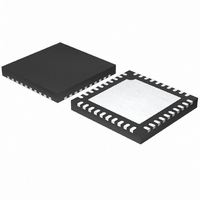MAX1544ETL+ Maxim Integrated Products, MAX1544ETL+ Datasheet - Page 28

MAX1544ETL+
Manufacturer Part Number
MAX1544ETL+
Description
IC QUICK-PWM DUAL-PHASE 40-TQFN
Manufacturer
Maxim Integrated Products
Series
Quick-PWM™r
Datasheet
1.MAX1544ETLT.pdf
(42 pages)
Specifications of MAX1544ETL+
Applications
Controller, AMD Hammer
Voltage - Input
2 ~ 28 V
Number Of Outputs
1
Voltage - Output
0.68 ~ 1.55 V
Operating Temperature
-40°C ~ 100°C
Mounting Type
Surface Mount
Package / Case
40-TQFN Exposed Pad
Output Voltage
0.675 V to 1.55 V
Output Current
40 A
Input Voltage
4 V to 28 V
Mounting Style
SMD/SMT
Maximum Operating Temperature
+ 100 C
Minimum Operating Temperature
- 40 C
Lead Free Status / RoHS Status
Lead free / RoHS Compliant
Dual-Phase, Quick-PWM Controller for
AMD Hammer CPU Core Power Supplies
The multiphase Quick-PWM controllers include a third
amplifier used to add small offsets to the voltage-posi-
tioned load line. The offset amplifier is summed directly
with the feedback voltage, making the offset gain inde-
pendent of the DAC code. This amplifier has the ability
to offset the output by ±100mV.
The offset is adjusted using resistive voltage-dividers at
the OFS input. For inputs from 0 to 0.8V, the offset
amplifier adds a negative offset to the output that is
equal to 1/8 the voltage appearing at the selected OFS
input (V
1.2V to 2V, the offset amplifier adds a positive offset to
the output that is equal to 1/8th the difference between
the reference voltage and the voltage appearing at the
selected OFS input (V
V
positive and negative offsets with a single input. The
piecewise linear transfer function is shown in the
Typical Operating Characteristics. The regions of the
transfer function below zero, above 2V, and between
0.8V and 1.2V are undefined. OFS inputs are disal-
lowed in these regions, and the respective effects on
the output are not specified.
The controller disables the offset amplifier during sus-
pend mode (SUS = REF or high).
During normal mode, when the CPU is actively running
(SKIP = high, Table 7), the Quick-PWM controller oper-
ates with the low-noise forced-PWM control scheme.
Forced-PWM operation disables the zero-crossing
comparator, forcing the low-side gate-drive waveform
to be constantly the complement of the high-side gate-
drive waveform. This keeps the switching frequency
fairly constant and allows the inductor current to
Table 7. S S K K I I P P Settings*
*Settings for a dual 180° out-of-phase controller.
28
OFS
CONNECTION
(3.3V or V
______________________________________________________________________________________
)). With this scheme, the controller supports both
SKIP
High
GND
Forced-PWM Operation (Normal Mode)
REF
OUT
CC
= V
)
DAC
pulse skipping
pulse skipping
forced PWM
Two-phase
Two-phase
One-phase
- 0.125 × V
MODE
OUT
= V
DAC
OFS
The controller operates with a constant switching frequency, providing low-noise forced-PWM
operation. The controller disables the zero-crossing comparators, forcing the low-side gate-
drive waveform to be constantly the complement of the high-side gate-drive waveform.
The controller automatically switches over to PFM operation under light loads. The controller
keeps both phases active and uses the automatic pulse-skipping control scheme, alternating
between the primary and secondary phases with each cycle.
The controller automatically switches over to PFM operation under light loads. Only the main
phase is active. The secondary phase is disabled, DLS and DHS are pulled low, so LXS is a
high impedance.
+ 0.125 × (V
). For inputs from
Offset Amplifier
REF
-
reverse under light loads, providing fast, accurate neg-
ative output voltage transitions by quickly discharging
the output capacitors.
Forced-PWM operation comes at a cost: the no-load 5V
bias supply current remains between 10mA to 60mA
per phase, depending on the external MOSFETs and
switching frequency. To maintain high efficiency under
light-load conditions, the processor may switch the
controller to a low-power pulse-skipping control
scheme after entering suspend mode.
During pulse-skipping override mode (SKIP = REF or
GND, Table 7), the multiphase Quick-PWM controllers
use an automatic pulse-skipping control scheme. When
SKIP is pulled low, the controller uses the automatic
pulse-skipping control scheme, overriding forced-PWM
operation, and blanks the upper VROK threshold.
Figure 6. Offset Voltage
OPERATION
-100
-200
200
100
0
0
Low-Power Pulse Skipping
0.5
OFS VOLTAGE (V)
0.8
1.0
1.2
UNDEFINED
REGION
1.5
2.0











